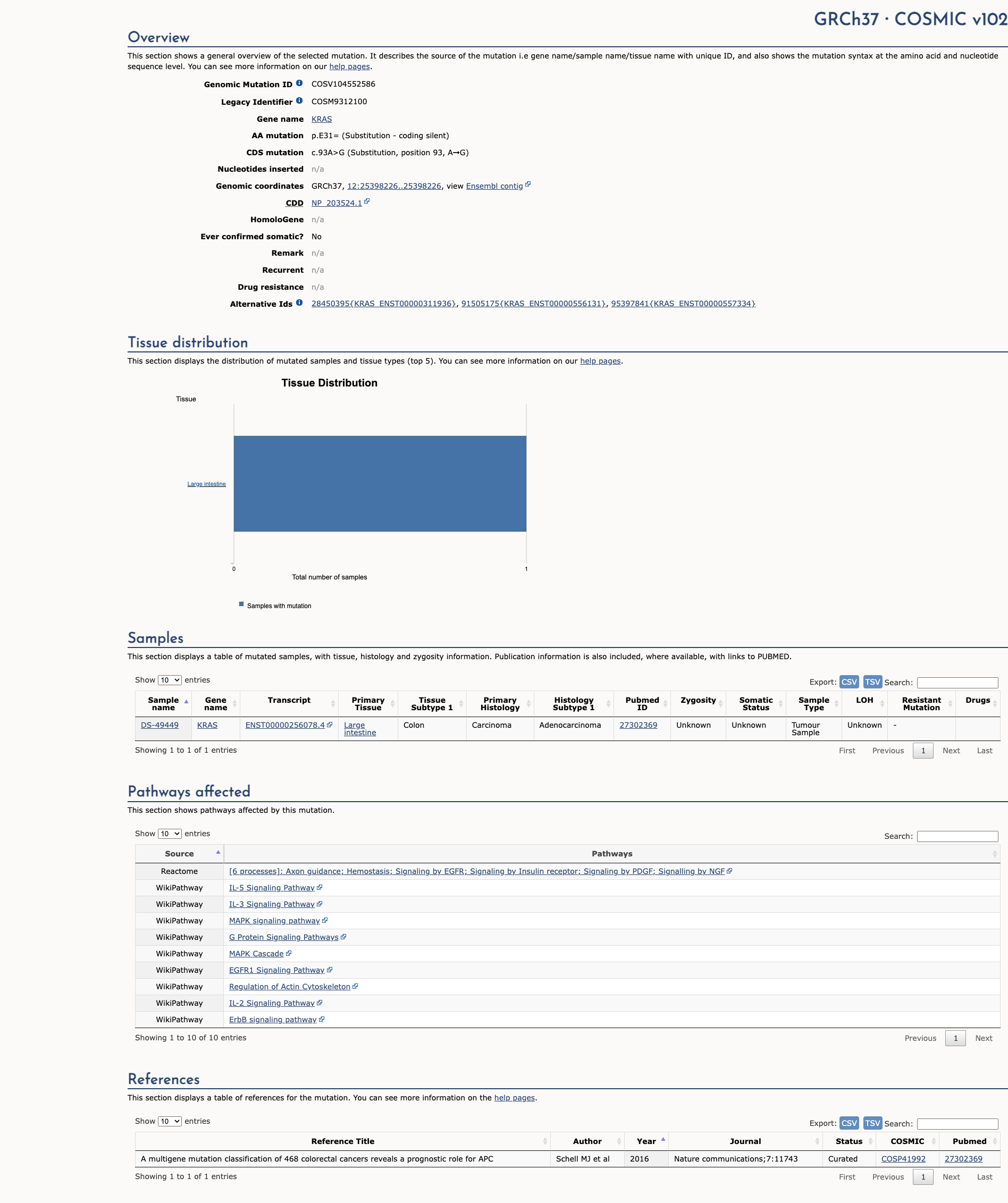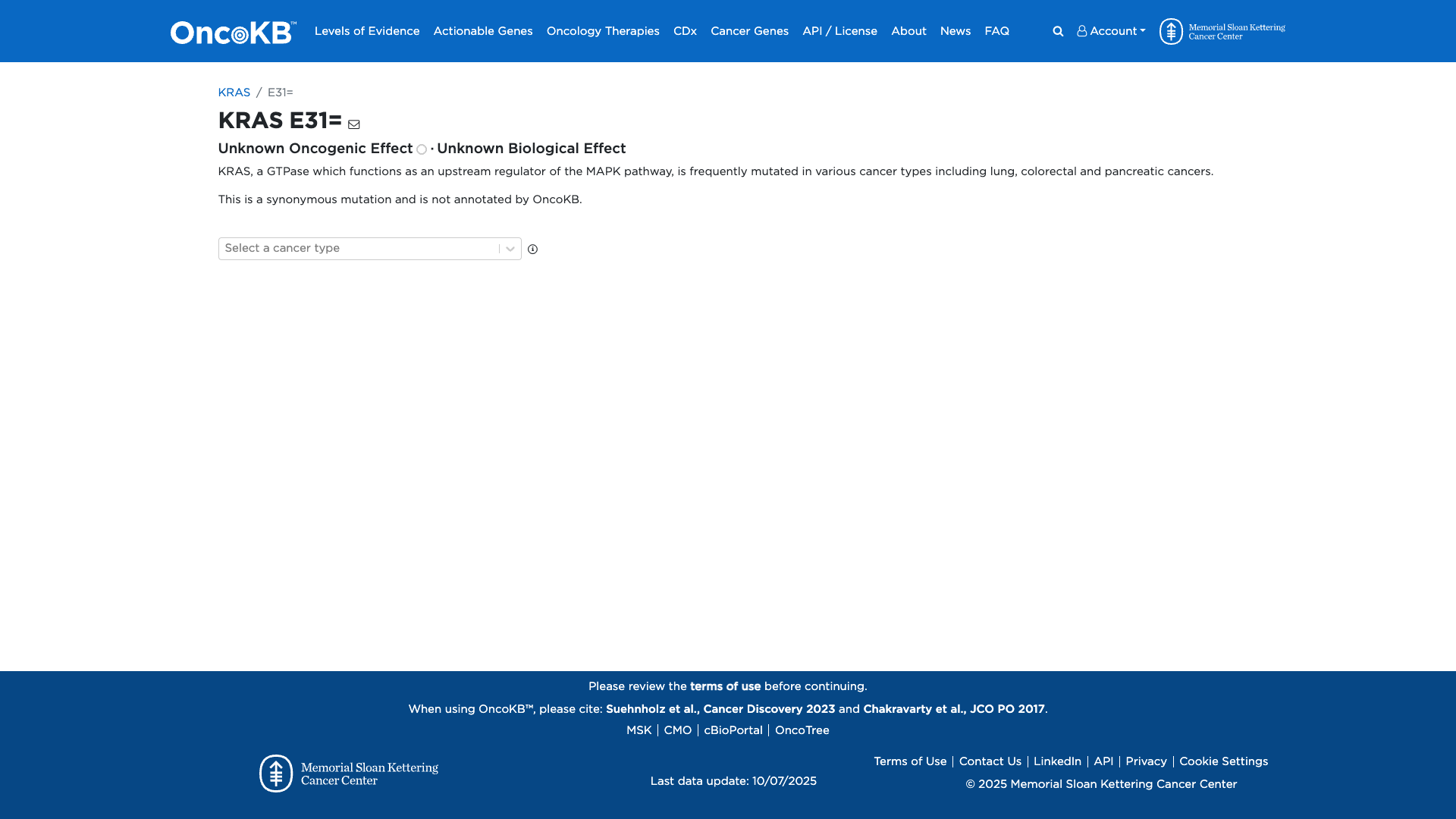KRAS c.93A>G, p.Glu31=
NM_033360.4:c.93A>G
COSMIC ID: COSM9312101
Variant of Uncertain Significance (VUS)
This synonymous KRAS variant (E31=) shows no change to the amino acid sequence, no predicted splicing impact (BP7), and lacks evidence for pathogenicity or allele frequency thresholds. Only one benign supporting criterion is met, insufficient for benign classification. Therefore, the variant remains a Variant of Uncertain Significance (VUS).
ACMG/AMP Criteria Applied
BP7
Genetic Information
Gene & Transcript Details
Gene
KRAS
Transcript
NM_033360.2
Total Exons
6
Strand
Reverse (−)
Reference Sequence
NC_000012.11
Alternative Transcripts
| ID | Status | Details |
|---|---|---|
| NM_033360.4 | Alternative | 6 exons | Reverse |
| NM_033360.3 | Alternative | 6 exons | Reverse |
Variant Details
HGVS Notation
NM_033360.4:c.93A>G
Protein Change
E31=
Location
Exon 2
(Exon 2 of 6)
5'Exon Structure (6 total)3'
Functional Consequence
Loss of Function
Related Variants
Alternate Identifiers
COSM9312101
Variant interpretation based on transcript NM_033360.2
Genome Browser
Loading genome browser...
HGVS InputNM_033360:c.93A>G
Active Tracks
ConservationRefSeqClinVargnomAD
Navigation tips: Use mouse to drag and zoom. Click on features for details.
Clinical Data
Global Frequency
0.0018%
Rare
Highest in Population
African/African American
0.00818%
Rare
Global: 0.0018%
African/African American: 0.00818%
0%
0.05%
0.1%
1%
5%
10%+
Allele Information
Total: 277354Alt: 5Homozygotes: 0
ACMG Criteria Applied
PM2
This variant is present in gnomAD (MAF= 0.0018%, 5/277354 alleles, homozygotes = 0) and at a higher frequency in the African/African American population (MAF= 0.00818%, 2/24448 alleles, homozygotes = 0). The variant is rare (MAF < 0.1%), supporting PM2 criterion application.
Classification
Uncertain Significance (VUS)
Based on 6 submitter reviews in ClinVar
Submitter Breakdown
1 VUS
5 LB
Pathogenic
Likely Path.
VUS
Likely Benign
Benign
Publications (0)
No publication details.
Clinical Statement
This variant has been reported in ClinVar as Likely benign (5 clinical laboratories) and as Uncertain significance (1 clinical laboratories).
Functional Impact
Functional Domain
Hotspot Status
Not a hotspot
Domain Summary
This variant is not located in a mutational hotspot or critical domain (0 mutations).
Related Variants in This Domain
Computational Analysis
Pathogenicity Predictions
Predictor Consensus
Mixed/VUS
PP3 Applied
No
Additional Predictors
Benign:
CADD: 0.71
VCEP Guidelines
Applied ACMG/AMP Criteria (VCEP Specific) VCEP Guidelines
PVS1
PVS1 (Not Applied) Strength Modified
According to standard ACMG guidelines the rule for PVS1 is: "Null variant (nonsense, frameshift, start codon, splicing +1/2, startgain, single or multi-exon deletion) in a gene where LOF is a known mechanism of disease." The evidence for this variant shows: it is a synonymous (silent) variant, not predicted to produce a null allele. Therefore, this criterion is not applied.
PS1
PS1 (Not Applied) Strength Modified
According to VCEP guidelines the rule for PS1 is: "Strong Same amino acid change as a previously established pathogenic variant regardless of nucleotide change (including analogous residues in HRAS, KRAS, MRAS, NRAS, RIT1, RRAS2)." The evidence for this variant shows: it is a synonymous change (E31=), so no amino acid change. Therefore, this criterion is not applied.
PS2
PS2 (Not Applied) Strength Modified
According to VCEP guidelines the rule for PS2 is: "Very Strong if de novo (both maternity and paternity confirmed) or Strong/Moderate if de novo with varying points." The evidence for this variant shows: de novo status is unknown. Therefore, this criterion is not applied.
PS3
PS3 (Not Applied) Strength Modified
According to VCEP guidelines the rule for PS3 is: "Moderate if two or more different approved assays show a deleterious effect; Supporting if one approved assay." The evidence for this variant shows: no functional studies have been performed. Therefore, this criterion is not applied.
PS4
PS4 (Not Applied) Strength Modified
According to VCEP guidelines the rule for PS4 is: "Strong if ≥5 proband points; Moderate if ≥3; Supporting if ≥1." The evidence for this variant shows: no case‐control or proband data supporting enrichment in affected individuals. Therefore, this criterion is not applied.
PM1
PM1 (Not Applied) Strength Modified
According to VCEP guidelines the rule for PM1 is: "Moderate for variants in critical functional domains (P-loop AA10-17, SW1 AA25-40, SW2 AA57-64, SAK AA145-156)." The evidence for this variant shows: it is synonymous and does not alter amino acid sequence within SW1. Therefore, this criterion is not applied.
PM2
PM2 (Not Applied) Strength Modified
According to VCEP guidelines the rule for PM2 is: "Supporting: The variant must be absent from controls (gnomAD)." The evidence for this variant shows: it is present in gnomAD at MAF 0.0018%. Therefore, this criterion is not applied.
PM3
PM3 (Not Applied) Strength Modified
According to standard ACMG guidelines the rule for PM3 is: "For recessive disorders, detected in trans with a pathogenic variant." The evidence for this variant shows: no evidence of trans configuration in a recessive context. Therefore, this criterion is not applied.
PM4
PM4 (Not Applied) Strength Modified
According to VCEP guidelines the rule for PM4 is: "Moderate for protein length changes due to in-frame deletions/insertions outside repetitive regions." The evidence for this variant shows: it is synonymous with no indel. Therefore, this criterion is not applied.
PM5
PM5 (Not Applied) Strength Modified
According to VCEP guidelines the rule for PM5 is: "Strong if ≥2 different known pathogenic residue changes at the same codon in ≥5 probands; Moderate if 1 pathogenic residue change." The evidence for this variant shows: it is synonymous and does not change the residue. Therefore, this criterion is not applied.
PM6
PM6 (Not Applied) Strength Modified
According to VCEP guidelines the rule for PM6 is: "Strong/Moderate/Supporting for unconfirmed de novo occurrences with varying point values." The evidence for this variant shows: de novo status is unknown. Therefore, this criterion is not applied.
PP1
PP1 (Not Applied) Strength Modified
According to VCEP guidelines the rule for PP1 is: "Supporting/Moderate/Strong based on number of informative meioses." The evidence for this variant shows: no segregation data available. Therefore, this criterion is not applied.
PP2
PP2 (Not Applied) Strength Modified
According to standard ACMG guidelines the rule for PP2 is: "Supporting for missense variants in a gene with low rate of benign missense variants and where missense is a common mechanism." The evidence for this variant shows: it is synonymous, not missense. Therefore, this criterion is not applied.
PP3
PP3 (Not Applied) Strength Modified
According to VCEP guidelines the rule for PP3 is: "Supporting for missense variants with REVEL ≥0.7 or splicing predictions matching disease mechanism." The evidence for this variant shows: it is synonymous and splicing predictors show no impact. Therefore, this criterion is not applied.
PP4
PP4 (Not Applied) Strength Modified
According to standard ACMG guidelines the rule for PP4 is: "Supporting when patient phenotype is highly specific for a single gene disorder." The evidence for this variant shows: no patient phenotype data provided. Therefore, this criterion is not applied.
PP5
PP5 (Not Applied) Strength Modified
According to standard ACMG guidelines the rule for PP5 is: "Supporting when a reputable source reports the variant as pathogenic without primary evidence." The evidence for this variant shows: ClinVar entries are conflicting (Likely benign and VUS). Therefore, this criterion is not applied.
BA1
BA1 (Not Applied) Strength Modified
According to VCEP guidelines the rule for BA1 is: "Stand Alone if gnomAD filtering allele frequency ≥0.05%." The evidence for this variant shows: MAF = 0.0018%, below threshold. Therefore, this criterion is not applied.
BS1
BS1 (Not Applied) Strength Modified
According to VCEP guidelines the rule for BS1 is: "Strong if gnomAD filtering allele frequency ≥0.025%." The evidence for this variant shows: MAF = 0.0018%, below threshold. Therefore, this criterion is not applied.
BS2
BS2 (Not Applied) Strength Modified
According to standard ACMG guidelines the rule for BS2 is: "Strong/Supporting when observed in healthy adult individuals for disorders with full penetrance." The evidence for this variant shows: no observations in well‐characterized healthy cohorts. Therefore, this criterion is not applied.
BS3
BS3 (Not Applied) Strength Modified
According to standard ACMG guidelines the rule for BS3 is: "Strong when well‐established functional studies show no damaging effect." The evidence for this variant shows: no functional study data. Therefore, this criterion is not applied.
BS4
BS4 (Not Applied) Strength Modified
According to standard ACMG guidelines the rule for BS4 is: "Strong when lack of segregation in affected members of a family." The evidence for this variant shows: segregation data unavailable. Therefore, this criterion is not applied.
BP1
BP1 (Not Applied) Strength Modified
According to VCEP guidelines the rule for BP1 is: "Supporting for truncating variants in genes where gain-of-function is disease mechanism." The evidence for this variant shows: it is synonymous, not truncating. Therefore, this criterion is not applied.
BP2
BP2 (Not Applied) Strength Modified
According to standard ACMG guidelines the rule for BP2 is: "Supports benign when observed in trans with a pathogenic variant for a dominant disorder or cis with another pathogenic variant for recessive." The evidence for this variant shows: no such observations. Therefore, this criterion is not applied.
BP3
BP3 (Not Applied) Strength Modified
According to standard ACMG guidelines the rule for BP3 is: "Supporting when in-frame indels in repetitive regions without known function." The evidence for this variant shows: it is synonymous, not an indel. Therefore, this criterion is not applied.
BP4
BP4 (Not Applied) Strength Modified
According to VCEP guidelines the rule for BP4 is: "Supporting for missense variants with REVEL ≤0.3." The evidence for this variant shows: it is synonymous, not missense, despite benign computational predictions. Therefore, this criterion is not applied.
BP5
BP5 (Not Applied) Strength Modified
According to standard ACMG guidelines the rule for BP5 is: "Supporting when a variant is found in a case with an alternate molecular basis for disease." The evidence for this variant shows: no such cases reported. Therefore, this criterion is not applied.
BP6
BP6 (Not Applied) Strength Modified
According to standard ACMG guidelines the rule for BP6 is: "Supporting when a reputable source reports the variant as benign without evidence." The evidence for this variant shows: ClinVar submissions include Likely benign but with conflicting calls. Therefore, this criterion is not applied.
BP7
BP7 (Supporting)
According to VCEP guidelines the rule for BP7 is: "Supporting A synonymous (silent) variant for which splicing prediction algorithms predict no impact to the splice consensus sequence nor the creation of a new splice site AND the nucleotide is not highly conserved." The evidence for this variant shows: it is synonymous (E31=), SpliceAI predicts no impact on splicing, and the nucleotide is not highly conserved. Therefore, this criterion is applied at Supporting strength.



